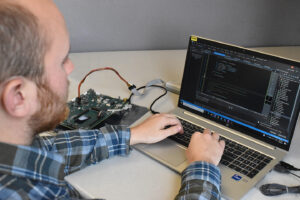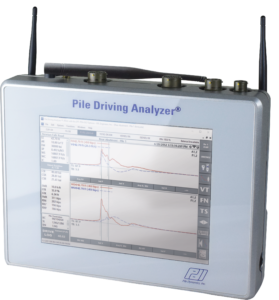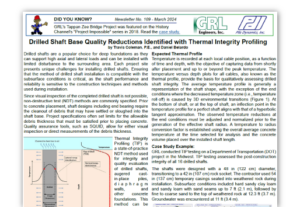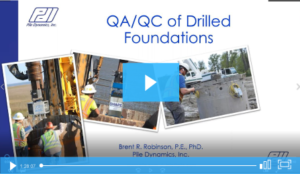What is the maximum size foundation that can be tested with the PIT?
Typically, the maximum size of foundation for PIT testing is specified in terms of the maximum Length (L) over Diameter (D) ratio. Previously, an L/D ratio of 30 was designated as the maximum for PIT tests. This is because when using older electronics to test piles or shafts longer than 30 times their diameter input, the toe reflection would become depleted by shaft soil resistance making it unobservable. In actual practice, the ratio limit can be higher or lower than 30, depending on several factors. Those factors include:
•The length of foundation subjected to skin friction; the part of the pile or shaft above grade or in very soft soil has very little influence on the total length that can be tested.
•The amount of skin friction; very high soil resistance can reduce the maximum length, while very low resistance throughout most of the shaft may allow longer foundation elements to be tested.
•The amount of end bearing; a clear toe reflection requires some soil elasticity at the toe, which creates a tension reflection since the underlying soil stiffness is considerably weaker than the foundation. Very rigid soil or rock may result in a compression reflection or an unclear toe reflection.
•Hollow piles with relatively thin walls; these piles are difficult to test even in the best of conditions because a plane wave will never be attained. The maximum length will be limited.
•Piles or shafts with variable cross-sections or material properties; impedance variations reflect the wave making it difficult to assess the integrity of the foundation below the first major change.
•Piles with splices can reflect the wave; it may be impossible to evaluate the integrity of the pile below the first splice.
•Foundations with cracks; even cracks not detrimental to the foundation may cause strong reflections making a clear toe reflection undetectable.
•Very long large diameter piles or shafts; the attenuation of the wave due to soil resistance and to internal damping may pose difficulties detecting a toe reflection on foundations longer than 50 m (160 ft).
•Long timber piles; because of the reflections caused by these piles tapered shape, a clear toe reflection may be undetectable on timber piles longer than 15 m (50 ft).
•Quality of the electronics used; low noise circuits and the use of high resolution (≤16 bits) A/D converters allow the PIT to go beyond the usual L/D limitation. As a result, ratio values of 60 or more can be expected in many cases.
•Piles in structure; reflections from existing structures might limit the maximum L/D ratio that can be tested.
Occasionally, the test can assess the integrity of the foundation up to a certain depth. The test could confirm the absence of a major defect in the upper part of the foundation or in the upper zone of the lateral movement. As a result, the engineer would have a sufficient amount of information to eliminate major concern.
Return to FAQs



